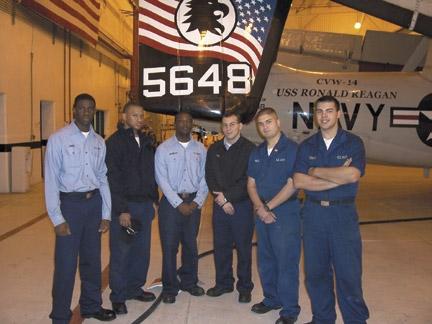
14 minute read
Maintainer’s Review of the Aviation Maintenance Safety Conference
By AMC(AW) Paul Hofstad

Advertisement

Continuing efforts to interact with the fleet and to stay in touch with their needs, the Aviation Maintenance Branch (Code 12) at the Naval Safety Center recently held the fourth gathering of maintenance and safety professionals in Norfolk, Va. More than 200 Sailors, Marines and civilians attended the Aviation Maintenance Safety Conference held 18- 21 April.
The four-day event included presenters from the Naval Safety Center and from the aviation maintenance community. The discussions included aircraft maintenance, aviation programs, vehicle safety, and much more.
Commander, Naval Safety Center, RADM George Mayer opened the conference with remarks about the recent plateau in mishap rates, and the focus of leadership of personnel issues—human factors and skillbased errors.

He challenged the attendees to continue their efforts to maintain a good on-the-job safety record and urged the assembled officers, chiefs and senior petty officers to look at off-duty issues, too. He spoke of the challenge ahead of us as we try to reduce mishaps 75 percent over the next few years—by the end of FY 2008. A key part of that effort is risk management, and he reminded the audience that a critical step in moving ahead is taking the lessons learned at work home at night.
Some other topics discussed and ideas shared included the renewed effort to emphasize or reintroduce ORM, the top-ten discrepancies found during safety surveys, changes to various safety programs, and introductions to new equipment and technologies.
More than 10 different commands presented information on policies, programs or innovative ideas that
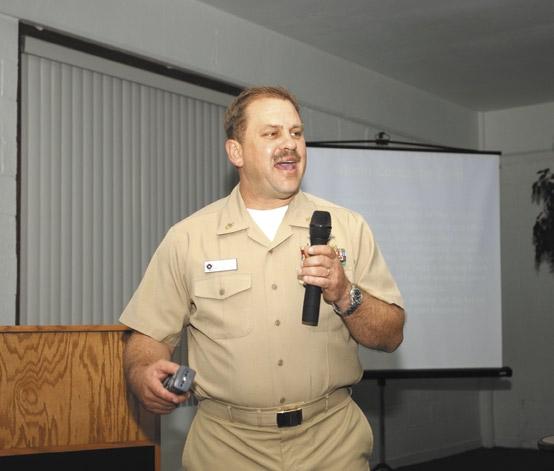
will make Sailors, Marines and Civilian’s lives easier, better, safer, cleaner, or will save money.
This conference could not happen without the dedicated personnel in the Naval Safety Center or from the many other commands who helped make the conference a reality. A list of those commands that attended the conference and played a vital role in the sharing of safety information is included below. The Naval Safety Center wants to thank each and every one of them for their participation and continued support.
Next year’s conference is being planned for April at NAS North Island, Calif. We hope as many commands as possible will attend and will continue to work on reducing mishaps, improving safety awareness, and sharing ideas to make commands safer and better.
Senior Chief Hofstad is a maintenance analyst at the Naval Safety Center and the coordinator of the Crossfeed section of Mech magazine. He recently was selected for the Warrant Officer program.
Commands Represented at the Fourth Annual Aviation Maintenance Safety Conference
SHIPS USS Theodore Roosevelt USS Harry Truman USS Nimitz USS Saipan USS Bataan
ACC 2nd CG MTAT/MCAS Cherry Pt MARFORCOM ALD-B MARFORPAC ALT-D/K-Bay CPRG/NAS Norfolk CNATRA Wing One/Meridian CSCWL/NAS JAX CVWP NAS Whidbey Island CPRW-2/MCAS Kaneohe Bay CPRW-5/NAS Brunswick 1st MAW MWHS-1/Futema 2nd MAW/MCAS Cherry Point 3rd MAW ALMAT/Miramar 4th MAW/New Orleans

MALS MALS-14/Cherry Point MALS-26/Cherry Point MALS-29/MCAS New River MALS-31/MCAS Beaufort MALS 36/Okinawa MALS-39/MCAS Miramar
AIMD AIMD Oceana AIMD Pax River AIMD Fallon AIMD North Island AIMD Whidbey Island AIMD Willow Grove AIMD Fort Worth AIMD New Orleans AIMD Jacksonville AIMD Brunswick SQUADRONS TEST/ADVERSARY TEST VFA-31/NAS Oceana VC-6/Norfolk DET HX-21/NAS Pax River VFA-32/NAS Oceana VC-6/NAS Dam Neck VFA-87/NAS Oceana VX-20/NAS Pax River NAVAIR VFA-105/NAS Oceana VX-23/NAS Pax River NAVAIR 6.4/Pax River VFA-106/NAS Oceana NAVTESTWINGLANT/Pax River CNAF/AMMT (East) VFA-131/NAS Oceana AIRTEVRON 23/Pax River VMFA-134/MCAS Miramar VMFA-101/MCAS Miramar HELICOPTERS CIVILIAN/SCHOOL/NADEP VFA-125/NAS Lemoore MINE COUNTERMEASURES CNATTU Norfolk VFA-86/MCAS Beaufort HM-14/NAS Norfolk TSC Hampton Roads VMFT-401/MCAS Yuma CNI/Occptl. Safety Pax River COMBAT SUPPORT ASEMICAP EARLY WARNING HSC-3/NAS North Island NADEP/North Island VAW-117/NAS Pt. Mugu HCS-4/NAS Norfolk NAS Whidbey Island SAR VAW-123/NAS Norfolk HSC-25/NAS Guam Wyle Lab/Virginia Beach VAW-124/NAS Norfolk HSC-26/NS Norfolk Boeing Integrated/Seattle VQ-4/Oklahoma City HSC-28/NAS Norfolk HSC-85/NAS North Island SEA CONTROL VS-31/NAS Jacksonville MEDIUM/HEAVY LIFT VS-33/NAS North Island HMM-265/MCAS Okinawa HMH-769/Edwards AFB, CA ELECTRONIC WARFARE HMM-774/NAS Norfolk VAQ-129/NAS Whidbey Island HMT-303/Camp Pendleton VAQ-138/NAS Whidbey Island VAQ-132/MCAS Iwakuni LIGHT ATTACK HMLA-773/NAS Atlanta PATROL VPU-1/NAS Brunswick LAMPS VP-10/NAS Brunswick HSL-43/Nas North Island VP-69/NAS Whidbey Island HSL-37/MCAS Kaneohe Bay HSL-44/NAS Mayport LOGISTICS HSL-45/NAS North Island VR-1/NAF Washington DC HSL-49/NAS North Island VR-46/NAS Atlanta HSL-51/NAF Atsugi VR-54/NAS New Orleans VR-55/NAS Pt. Mugu CARGO/REFUELING VR-58/NAS Jacksonville HC-2/NAS Norfolk VR-61/NAS Whidbey Island HS-6/NAS North Island VR-62/NAS Brunswick VMGR-452/Stewart ANGB NY
Send BZs to: SAFE-Mech@navy.mil



AD3 Jacoby and AD2 Jarvis HSC-2

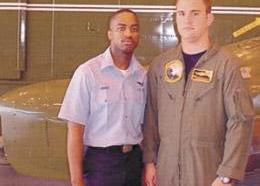


Petty Officer Jacoby was flying as the crew chief on Redhawk 732. While in straight and level flight, he heard a strange noise coming from the transmission area. He immediately investigated the noise and called for a check of the gauges. No one else heard the noise, and no other indications were noted. After 732 safely landed, Petty Officer Jacoby inspected the transmission and tail drive-shaft areas, discussed what he had heard with maintenance control, and convinced them to investigate further.
With little information to help, Petty Officer Jarvis meticulously inspected the transmission and tail drive-shaft areas. He found the transmission oil cooler had rotated, the belts were loose, and an oil line was rubbing on the airframe.
AM2 Daniel Dominguez HM-15
After a hydraulic line for the main-rotor-blade fold on an MH53E ruptured, Petty Officer Dominguez was called to clean up the massive hydraulic leak. While cleaning the pylon section of the helicopter, he found two cracks in the skin of the aircraft.
Petty Officer Dominguez immediately notified maintenance control and quality assurance, and the cracks were “stop drilled,” allowing the aircraft to continue its mission and preventing a catastrophic failure.
ADAN Misha McMath HSC-28
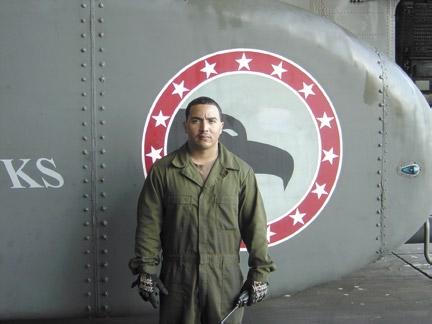

While doing a routine maintenance inspection on Ghostrider 41, Airman McMath found a cracked inner race on the bifilar assembly for the main rotor head. She immediately reported the downing discrepancy to maintenance control.
Her keen attention to detail resulted in her finding a problem that was not clearly obvious, could have been missed easily, and would have had potentially catastrophic results.
Ordnance Mechanic-Artisan John Collandra Naval Air Depot, Jacksonville
While inspecting and overhauling a BRU-14A, Mr. Collandra had to replace an auxiliary-unlock-switch assembly. After removing the replacement part from the shipping package, he did a pre-installation inspection of the component, even though that step was not part of written procedures. Looking inside the threaded M55 CAD hole for the unlock spring, he didn’t see it.
The part was disassembled, uncovering a factory defect. Because the assembly uses a shear wire, no mechanical check of the unlock assembly is done once the BRU is assembled. Had this discrepancy gone unnoticed, the spring position would have locked the store to the rack, preventing release of a loaded weapon. His actions led to Aviation Armament Bulletin (AAB) No. 709.

AMAN John Thaves HSL-42

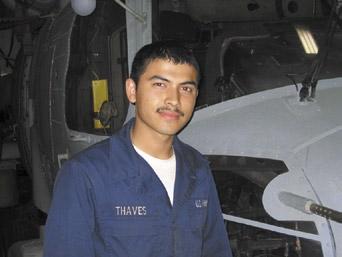
Airman Thaves discovered a missing cotter pin on the yaw channel of the mixing unit of Proud Warrior 430 during a 56-day inspection. A closer inspection showed the bolt had broken torque standards.
Had this discrepancy gone unnoticed, it could have resulted in catastrophic failure of the tail-rotor, flightcontrol system.
AD3 Mark Fronda VAW-113
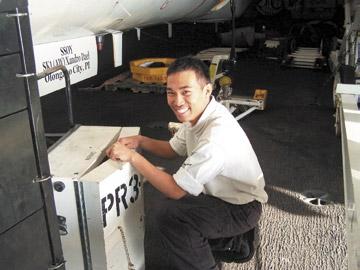
Petty Officer Fronda found a crack on the propeller of Black Eagle 600 that, if left undetected, could have led to the loss of the aircraft.
He discovered the problem while doing a corrosion inspection on the No. 3 blade of the port propeller assembly. He first noticed what appeared to be a hairline crack in the fiberglass on the camber-side inspection window. But a closer look revealed that the crack ran beyond the length of the front propeller inspection window and along the spar line.
PR2(AW) Gary Vaughn AIMD, NAS Jacksonville
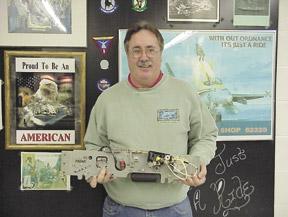
Petty Officer Vaughn was tasked to fix a loss-of-vacuum discrepancy on a thin-pack parachute. Upon pulling the ripcord, the pilot chute did not deploy. Taking a closer look, Vaughn found the top and bottom container flaps had been tacked together, keeping the parachute container from opening. At this time, he advised QA of this life-threatening maintenance malpractice and completed a hazardous-material report, making sure the fleet was aware of this serious problem.
AMEAN William Hoye VAQ-139
Airman Hoye found the hand wheel for the top-latch mechanism still installed on the pilot’s ejection seat on an aircraft loaned from another squadron. Knowing this condition was unsafe, he quickly alerted the night-check supervisor and maintenance control. Had this problem not been caught and had the aircraft performed a negative-G maneuver, the pilot’s seat could have risen up the seat rails, triggering the command ejection sequence for the other three crewmen. While the rest of the crew would have completed the ejection sequence, the pilot would have been left only partly ejected.
PRAN Elizabeth Holmes VAQ-139
During a 14-day special inspection on the ejection seats of a recently received aircraft, Airman Holmes noticed the tacking on the parachute ripcords was incorrect on all four seats. Knowing the jet needed to be flown the following morning, she coordinated with AIMD to elevate the work request to a priority-one status. The parachutes were repaired and reinstalled in the aircraft in time for the next day’s flight schedule. Had this mistake not been caught, the parachutes inadvertently could have deployed inside the cockpit, restricting the pilot’s ability to control the aircraft and making a safe
ejection impossible.
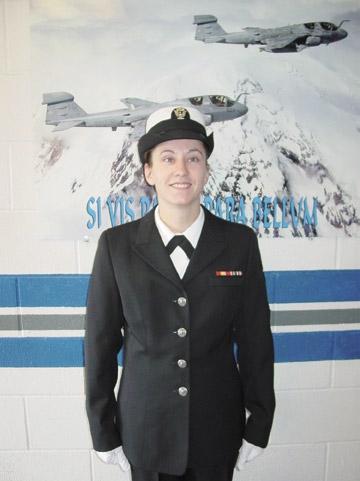
ATAN Rouving Kongsima VFA-143
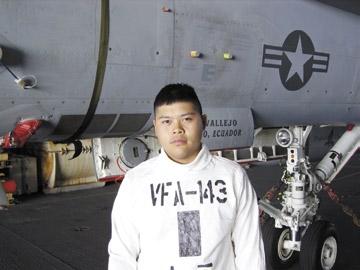
Airman Kongsima was preparing Dog 101 for the day’s flight schedule and keying confidential codes into the aircraft. Once given the signal that the cockpit switches had been checked, he applied shipboard power. Upon applying the power, he immediately noticed the aircraft’s wings began to spread. Two aircraft were parked adjacent to and within less than a foot of DOG 101.
Realizing that damage would have been inevitable for all three aircraft, Airman Kongsima quickly responded, removing power and preventing more than $1 million of damage.
AME1(AW) Diane Laraby VAQ-139
While preflighting Warcat 503 during a squadron detachment to NAS Fallon, Nev., Petty Officer Laraby discovered the cross-shaft retaining nut from the ECMO-3 ejection seat was missing. She quickly notified maintenance control and initiated a FOD inspection. Only after pulling the seat did she find the nut. The seat then was repaired and reinstalled in minimum time, allowing the squadron to complete all scheduled sorties. If this discrepancy had gone undiscovered, it could have caused catastrophic failure of the seat.

AM1(AW) Travis O’Dell VP-45
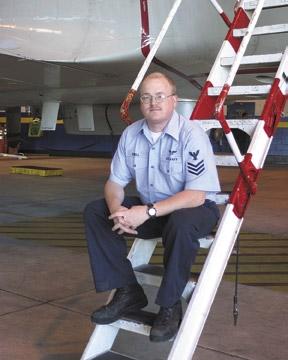
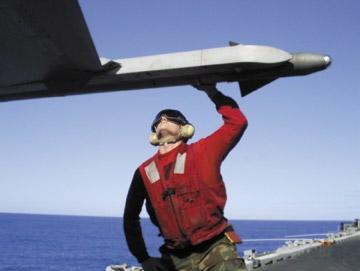
While operating at Al Udeid Air Base, Qatar with VP-45, Petty Officer O’Dell watched as a Royal Air Force Tornado developed a hydraulic fire on its main undercarriage shortly after landing. The rapidly developing fire was not immediately apparent to the crew in the cockpit. Petty Officer O’Dell, who was driving along an adjacent perimeter road at the time, quickly realized the severity of the situation and jumped into action. Locating the nearest fire bottle, he dragged it a considerable distance to the burning aircraft. With the assistance of the crew, whom he since had alerted to the emergency, Petty Officer O’Dell managed to extinguish the fire before it had time to destroy the aircraft.
AOAN Mark Kirchner VFA-136
AM1(AW) Chad Beck and AW3 Timothy Hollis HM-15

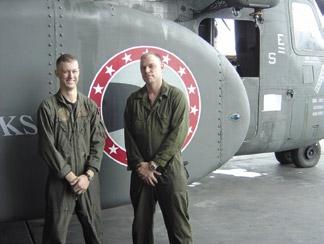
During a routine phase inspection on an MH-53E, Petty Officers Beck and Hollis were inspecting the tail rotor pylon when they found a bullet located on a pylon rib and an entry point in the top of the tail gearbox cowling. They immediately notified maintenance control and QA of this situation.
Their keen attention to detail led to the discovery of FOD and a damaged gearbox, preventing serious
injury to personnel or potential loss of aircraft.
While assigned to the CVW-1 arm/de-arm team, Airman Kirchner successfully identified two improperly loaded CATM-9X missiles on aircraft seconds before launch. These discoveries prevented possible injuries and loss of valuable training assets valued at more than $316,000. He displayed the professional behavior and characteristics found in more senior ordnancemen.
AMEAN Matthew Hamilton VQ-4, Detachment NAS Patuxent River, Md.
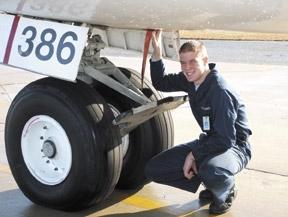
Airman Hamilton was doing his final inspection on the alert launch of Shadow 409 when he noticed the “T” handle still was installed in the nose landing gear. He immediately notified the aircrew to resolve the situation.
With the “T” handle installed, the aircrew would not have been able to retract the nose landing gear.
AM1(AW/NAC) Kenneth Jay VR-56
Petty Officer Jay began a normal preflight of a C-9B Skytrain. During his inspection, he checked the crew oxygen system for proper quantity and
AME3 Chad Petersen VAQ-139
During a pre-launch inspection of aircraft 501, Petty Officer Petersen noticed an anomaly with the main landing-gear doors. Despite being well beyond his normal area of responsibility and training, he discovered a broken aft lock-attachment lug on
Had this discrepancy flow through the installed masks. He discovered that the flow from all three flight-crew positions was weak at best. He also noticed that the LOX quantity gauge for the crew side indicated 8 liters, which would reflect a sufficient amount for the assigned mission.
After some troubleshooting, Petty Officer Jay found that the preceding nine “A-sheets” reflected the identical amount. This situation raised a flag, warranting further investigation. Petty Officer Jay immediately notified maintenance control and work center 130.
The 130 shop found the LOX bottles empty, and the gauge was stuck on the
the port, forward main-gear door.
8-liter mark. gone undiscovered, it could have caused catastrophic failure of aircraft 501’s landing gear.
AE2(AW) Larry Lowry & AM2(AW) Jamie Cain VFA-143
Petty Officers Lowery and Cain were troubleshooting a rudder-pedal binding discrepancy on Dog 105. During the inspection of the cockpit, Petty Officer Lowery saw something sticking out of the bulkhead in the port rudder-pedal area.
As he moved the pedals, he immediately noticed that there was only about one-eighthinch of movement. Upon further inspection, they noticed that an avionics cooling-fan filter caused the binding situation on the port rudder pedal. Petty Officer Cain also found one of the mounting tabs on the filter housing was bent because of excessive contact with the rudder pedal, causing extensive wear marks.
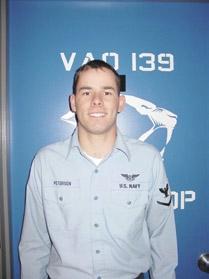
AT2 Jacob M. Dobbs VAQ-139
While doing a routine maintenance on aircraft 500 at NAS Fallon, Nevada, Petty Officer Dobbs noticed smoke coming from the station No. 1 jamming pod. It started after ground electrical power was applied.
Petty Officer Dobbs immediately removed electrical power, exposed the internal hardback wiring, and extinguished the fire.

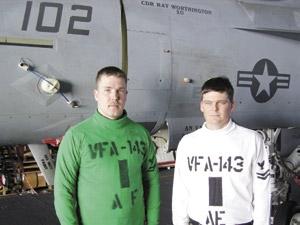
AN Brandon Crysell VAQ-133
During a pre-flight inspection of aircraft 532, Airman Crysell discovered a rivet stem laying on the outboard speed-brake fairing. Had this rivet been missed, it could have lodged in the speed brake, resulting in aircraft asymmetry and loss of flight control endangering aircrew.
AD1(AW) Ronald James VAQ-133
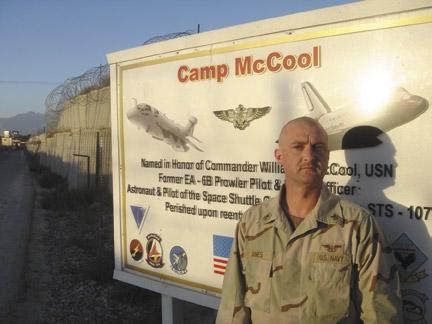

Petty Officer James noticed a British Tornado with hot brakes was being directed to park next to one of his EA-6Bs. He immediately directed the aircraft be sent to the hotbrake area and relayed this information to Maintenance Control, so the NAS Whidbey Island Fire Department could be
notified.
AA Claude Gibbs, AA Omar Redd, AA Michael Mordecai, AA Christopher Cox, AA Daniel Garcia, and AN Nicholas Hebdo (not pictured: AN Ryan Clayton and AR Paulo Adela) VAW-113
VAW-116 called VAW-113’s maintenance control to warn them that a wells unit was on fire. Airmen Clayton and Nicholas; Airman Apprentices Hebdo, Garcia, Redd, Cox, Mordecai, and Gibbs; and Airman Recruit Paulo Adela responded immediately. They quickly moved Black Eagle 602 out of harm’s way and then helped the fire-fighting crew put out the fire.
